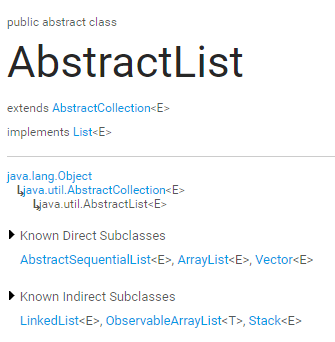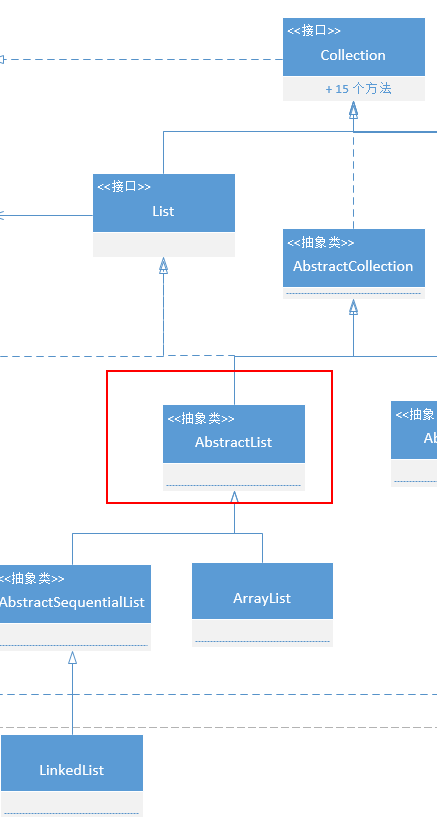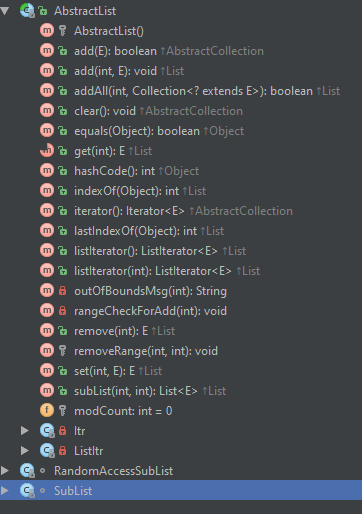Java 集合深入理解(6):AbstractList
今天心情比天藍,來學學 AbstractList 吧!
什麼是 AbstractList
AbstractList 繼承自 AbstractCollection 抽象類,實現了 List 介面 ,是 ArrayList 和 AbstractSequentiaList 的父類。
它實現了 List 的一些位置相關操作(比如 get,set,add,remove),是第一個實現隨機訪問方法的集合類,但不支援新增和替換。
在 AbstractCollection 抽象類 中我們知道,AbstractCollection 要求子類必須實現兩個方法: iterator() 和 size()。 AbstractList 實現了 iterator()方法:
public Iterator<E> iterator() {
return new Itr();
}
但沒有實現 size() 方法,此外還提供了一個抽象方法 get():
public abstract E get(int location);
因此子類必須要實現 get(), size() 方法。
另外,如果子類想要能夠修改元素,還需要重寫 add(), set(), remove() 方法,否則會報 UnsupportedOperationException 錯。
實現的方法
1.預設不支援的 add(), set(),remove():
public boolean add(E e) { add(size(), e); return true; } public void add(int index, E element) { throw new UnsupportedOperationException(); } public E set(int index, E element) { throw new UnsupportedOperationException(); } public E remove(int index) { throw new UnsupportedOperationException(); }
2.indexOf(Object) 獲取指定物件 首次出現 的索引:
public int indexOf(Object o) { //獲取 ListIterator,此時遊標位置為 0 ListIterator<E> it = listIterator(); if (o==null) { //向後遍歷 while (it.hasNext()) if (it.next()==null) //返回遊標的前面元素索引 return it.previousIndex(); } else { while (it.hasNext()) if (o.equals(it.next())) return it.previousIndex(); } return -1; }
在 ListIterator 中我們介紹了 遊標 的概念,每次呼叫 listIterator.next() 方法 遊標 都會後移一位,當 listIterator.next() == o 時(即找到我們需要的的元素),遊標已經在 o 的後面,所以需要返回 遊標的 previousIndex().
3.lastIndexOf(Object) 獲取指定物件最後一次出現的位置:
public int lastIndexOf(Object o) {
//獲取 ListIterator,此時遊標在最後一位
ListIterator<E> it = listIterator(size());
if (o==null) {
//向前遍歷
while (it.hasPrevious())
if (it.previous()==null)
//返回 it.nextIndex() 原因類似 2
return it.nextIndex();
} else {
while (it.hasPrevious())
if (o.equals(it.previous()))
return it.nextIndex();
}
return -1;
}
4.clear(), removeRange(int, int), 全部/範圍 刪除元素:
public void clear() {
//傳入由子類實現的 size()
removeRange(0, size());
}
protected void removeRange(int fromIndex, int toIndex) {
//獲取 ListIterator 來進行迭代刪除
ListIterator<E> it = listIterator(fromIndex);
for (int i=0, n=toIndex-fromIndex; i<n; i++) {
it.next();
it.remove();
}
}
5.addAll(int,Collection
兩種內部迭代器
與其他集合實現類不同,AbstractList 內部已經提供了 Iterator, ListIterator 迭代器的實現類,分別為 Itr, ListItr, 不需要我們去幫他實現。
Itr 程式碼分析:
private class Itr implements Iterator<E> {
//遊標
int cursor = 0;
//上一次迭代到的元素的位置,每次使用完就會置為 -1
int lastRet = -1;
//用來判斷是否發生併發操作的標示,如果這兩個值不一致,就會報錯
int expectedModCount = modCount;
public boolean hasNext() {
return cursor != size();
}
public E next() {
//時刻檢查是否有併發修改操作
checkForComodification();
try {
int i = cursor;
//呼叫 子類實現的 get() 方法獲取元素
E next = get(i);
//有迭代操作後就會記錄上次迭代的位置
lastRet = i;
cursor = i + 1;
return next;
} catch (IndexOutOfBoundsException e) {
checkForComodification();
throw new NoSuchElementException();
}
}
public void remove() {
if (lastRet < 0)
throw new IllegalStateException();
checkForComodification();
try {
//呼叫需要子類實現的 remove()方法
AbstractList.this.remove(lastRet);
if (lastRet < cursor)
cursor--;
//刪除後 上次迭代的記錄就會置為 -1
lastRet = -1;
expectedModCount = modCount;
} catch (IndexOutOfBoundsException e) {
throw new ConcurrentModificationException();
}
}
//檢查是否有併發修改
final void checkForComodification() {
if (modCount != expectedModCount)
throw new ConcurrentModificationException();
}
}
可以看到 Itr 只是簡單實現了 Iterator 的 next, remove 方法。
ListItr 程式碼分析:
//ListItr 是 Itr 的增強版
private class ListItr extends Itr implements ListIterator<E> {
//多了個指定遊標位置的構造引數,怎麼都不檢查是否越界!
ListItr(int index) {
cursor = index;
}
//除了一開始都有前面元素
public boolean hasPrevious() {
return cursor != 0;
}
public E previous() {
checkForComodification();
try {
//獲取遊標前面一位元素
int i = cursor - 1;
E previous = get(i);
//為什麼上次操作的位置是 遊標當前位置呢?哦,看錯了,遊標也前移了
lastRet = cursor = i;
return previous;
} catch (IndexOutOfBoundsException e) {
checkForComodification();
throw new NoSuchElementException();
}
}
//下一個元素的位置就是當前遊標所在位置
public int nextIndex() {
return cursor;
}
public int previousIndex() {
return cursor-1;
}
public void set(E e) {
if (lastRet < 0)
throw new IllegalStateException();
checkForComodification();
try {
//子類得檢查 lasRet 是否為 -1
AbstractList.this.set(lastRet, e);
expectedModCount = modCount;
} catch (IndexOutOfBoundsException ex) {
throw new ConcurrentModificationException();
}
}
public void add(E e) {
checkForComodification();
try {
int i = cursor;
AbstractList.this.add(i, e);
//又置為 -1 了
lastRet = -1;
cursor = i + 1;
expectedModCount = modCount;
} catch (IndexOutOfBoundsException ex) {
throw new ConcurrentModificationException();
}
}
}
ListItr 在 Itr 基礎上多了 向前 和 set 操作。
兩種內部類
在 subList 方法中我們發現在切分 子序列時會分為兩類,RandomAccess or not:
public List<E> subList(int fromIndex, int toIndex) {
return (this instanceof RandomAccess ?
new RandomAccessSubList<>(this, fromIndex, toIndex) :
new SubList<>(this, fromIndex, toIndex));
}
RandomAccess
public interface RandomAccess {
}
RandomAccess 是一個空的介面,它用來標識某個類是否支援 隨機訪問(隨機訪問,相對比“按順序訪問”)。一個支援隨機訪問的類明顯可以使用更加高效的演算法。
List 中支援隨機訪問最佳的例子就是 ArrayList, 它的資料結構使得 get(), set(), add()等方法的時間複雜度都是 O(1);
反例就是 LinkedList, 連結串列結構使得它不支援隨機訪問,只能按序訪問,因此在一些操作上效能略遜一籌。
通常在操作一個 List 物件時,通常會判斷是否支援 隨機訪問,也就是* 是否為 RandomAccess 的例項*,從而使用不同的演算法。
比如遍歷,實現了 RandomAccess 的集合使用 get():
for (int i=0, n=list.size(); i < n; i++)
list.get(i);比用迭代器更快:
for (Iterator i=list.iterator(); i.hasNext(); )
i.next();
實現了 RandomAccess 介面的類有:
ArrayList, AttributeList, CopyOnWriteArrayList, Vector, Stack 等。
SubList 原始碼:
// AbstractList 的子類,表示父 List 的一部分
class SubList<E> extends AbstractList<E> {
private final AbstractList<E> l;
private final int offset;
private int size;
//構造引數:
//list :父 List
//fromIndex : 從父 List 中開始的位置
//toIndex : 在父 List 中哪裡結束
SubList(AbstractList<E> list, int fromIndex, int toIndex) {
if (fromIndex < 0)
throw new IndexOutOfBoundsException("fromIndex = " + fromIndex);
if (toIndex > list.size())
throw new IndexOutOfBoundsException("toIndex = " + toIndex);
if (fromIndex > toIndex)
throw new IllegalArgumentException("fromIndex(" + fromIndex +
") > toIndex(" + toIndex + ")");
l = list;
offset = fromIndex;
size = toIndex - fromIndex;
//和父類使用同一個 modCount
this.modCount = l.modCount;
}
//使用父類的 set()
public E set(int index, E element) {
rangeCheck(index);
checkForComodification();
return l.set(index+offset, element);
}
//使用父類的 get()
public E get(int index) {
rangeCheck(index);
checkForComodification();
return l.get(index+offset);
}
//子 List 的大小
public int size() {
checkForComodification();
return size;
}
public void add(int index, E element) {
rangeCheckForAdd(index);
checkForComodification();
//根據子 List 開始的位置,加上偏移量,直接在父 List 上進行新增
l.add(index+offset, element);
this.modCount = l.modCount;
size++;
}
public E remove(int index) {
rangeCheck(index);
checkForComodification();
//根據子 List 開始的位置,加上偏移量,直接在父 List 上進行刪除
E result = l.remove(index+offset);
this.modCount = l.modCount;
size--;
return result;
}
protected void removeRange(int fromIndex, int toIndex) {
checkForComodification();
//呼叫父類的 區域性刪除
l.removeRange(fromIndex+offset, toIndex+offset);
this.modCount = l.modCount;
size -= (toIndex-fromIndex);
}
public boolean addAll(Collection<? extends E> c) {
return addAll(size, c);
}
public boolean addAll(int index, Collection<? extends E> c) {
rangeCheckForAdd(index);
int cSize = c.size();
if (cSize==0)
return false;
checkForComodification();
//還是使用的父類 addAll()
l.addAll(offset+index, c);
this.modCount = l.modCount;
size += cSize;
return true;
}
public Iterator<E> iterator() {
return listIterator();
}
public ListIterator<E> listIterator(final int index) {
checkForComodification();
rangeCheckForAdd(index);
//建立一個 匿名內部 ListIterator,指向的還是 父類的 listIterator
return new ListIterator<E>() {
private final ListIterator<E> i = l.listIterator(index+offset);
public boolean hasNext() {
return nextIndex() < size;
}
public E next() {
if (hasNext())
return i.next();
else
throw new NoSuchElementException();
}
public boolean hasPrevious() {
return previousIndex() >= 0;
}
public E previous() {
if (hasPrevious())
return i.previous();
else
throw new NoSuchElementException();
}
public int nextIndex() {
return i.nextIndex() - offset;
}
public int previousIndex() {
return i.previousIndex() - offset;
}
public void remove() {
i.remove();
SubList.this.modCount = l.modCount;
size--;
}
public void set(E e) {
i.set(e);
}
public void add(E e) {
i.add(e);
SubList.this.modCount = l.modCount;
size++;
}
};
}
public List<E> subList(int fromIndex, int toIndex) {
return new SubList<>(this, fromIndex, toIndex);
}
private void rangeCheck(int index) {
if (index < 0 || index >= size)
throw new IndexOutOfBoundsException(outOfBoundsMsg(index));
}
private void rangeCheckForAdd(int index) {
if (index < 0 || index > size)
throw new IndexOutOfBoundsException(outOfBoundsMsg(index));
}
private String outOfBoundsMsg(int index) {
return "Index: "+index+", Size: "+size;
}
private void checkForComodification() {
if (this.modCount != l.modCount)
throw new ConcurrentModificationException();
}
}
總結:SubList 就是吭老族,雖然自立門戶,等到要幹活時,使用的都是父類的方法,父類的資料。
所以可以通過它來間接操作父 List。
RandomAccessSubList 原始碼:
class RandomAccessSubList<E> extends SubList<E> implements RandomAccess {
RandomAccessSubList(AbstractList<E> list, int fromIndex, int toIndex) {
super(list, fromIndex, toIndex);
}
public List<E> subList(int fromIndex, int toIndex) {
return new RandomAccessSubList<>(this, fromIndex, toIndex);
}
}
RandomAccessSubList 只不過是在 SubList 之外加了個 RandomAccess 的標識,表明他可以支援隨機訪問而已,別無他爾。
總結:
AbstractList 作為 List 家族的中堅力量
- 既實現了 List 的期望
- 也繼承了 AbstractCollection 的傳統
- 還建立了內部的迭代器 Itr, ListItr
- 還有兩個內部子類 SubList 和 RandomAccessSublist;
百廢俱興,AbstractList 博採眾長,制定了 List 家族的家規,List 家族基礎已經搭建的差不多了。
List 家族在 AbstractList 的指導下出了幾個英豪,成為了 Java 世界的棟樑之才,具體細節,我們下回再續。



